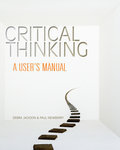
CRITICAL THINKING: A USER'S MANUAL offers an innovative skill-based approach to critical thinking that provides step-by-step tools for learning to evaluatearguments. Students build a complete skill set by recognizing, analyzing, diagramming, and evaluating arguments; later chapters encourage application of the basic skills to categorical, truth-functional, analogical, generalization, and causal arguments as well as fallacies. The exercises throughout the text engage readers in active learning, integrate writing as part of the critical thinking process, and emphasize skill transference. A special feature, called Your Turn! encourages students to not just skim through the book's explanations, but stop, think, and apply what they are learning. CRITICAL THINKING: A USER'S MANUAL offers multiple opportunities for different kinds of practice and options for appealing to different learning styles.The quantity and variety of exercises allow for group work, reflection and application, and writing practice as well as traditional homework exercises. Aplia, an online homework solution that increases student effort and engagement, is available as an option with this text to provide additional critical thinking practice with immediate feedback to reinforce the skills students are building in class. INDICE: Preface Acknowledgements 1. GETTING STARTED. Using Critical Thinking in the Classroom. Using Critical Thinking in the Workplace. Using Critical Thinking in the Martketplace. Forging an Examined Life. Developing Critical Thinking Skills. 2. RECOGNIZING ARGUMENTS. Identifying Claims. Counting Claims. Distinguishing Arguments from Explanations Distinguishing Arguments from OtherNon-Arguments. Putting it All Together: Recognizing Arguments. 3. ANALYZING ARGUMENTS. Analyzing Arguments with Inference Indicators. Analyzing Arguments without Inference Indicators. Analyzing Arguments with Extra Claims. Analyzing Arguments with Unstated Conclusions. Analyzing Arguments with Implied Claims. Analyzing Multiple Arguments Putting it All Together: Writing a Basic Analysis. 4. DIAGRAMMING ARGUMENTS. Diagramming Arguments. Utilizing Inference Indicators. Diagramming Arguments with Unstated Conclusions. Diagramming Arguments with Implied Claims. Diagramming Multiple Arguments. Checking Your Work. Diagramming Extended Arguments. Putting it All Together: A Basic Analysis with Argument Diagram. 5. DETECTING FALLICIES. Begging the Question. Appeal to Ignorance.Appeal to Illegitimate Authority. Ad Hominem Strawman. Red Herring. Appeal toEmotion. Putting it All Together: A Basic Analysis plus Fallacy Identification. 6. PREPARING TO EVALUATE ARGUMENTS. Distinguishing Two Styles of Reasoning.Distinguishing Two Kinds of Deductive Arguments. Distinguishing Three Kinds of Inductive Arguments. Choosing Proper Evaluative Terms. Putting it All Together: Writing a Complete Analysis. 7. EVALUATING CAREGORICAL ARGUMENTS. Recognizing Categorical Claims. Translating Categorical Claims. Recognizing Categorical Arguments. Analyzing Categorical Arguments. Evaluating Categorical Syllogisms. Using Venn Diagrams to Determine Validity. Using Rules to Determine Validity. Using Rules to Complete Categorical Arguments. Putting it All Together: A Complete Analysis plus Evaluation. 8. EVALUATING TRUTH-FUNCTIONAL ARGUMENTS. Recognizing Truth-Functional Claims. Translating Truth-Functional Claims. Using Proper Punctuation. Analyzing Truth-Functional Arguments. Identifying ArgumentForms to Determine Validity. Applying Truth-Functional Definitions. Using theTruth Table Method to Determine Validity. Using the Shortcut Method to Determine Validity. Putting it All Together: A Complete Analysis plus Evaluation. 9.EVALUATING ANALOGICAL ARGUMENTS. Recognizing Analogical Arguments. Analyzing Analogical Arguments. Evaluating the Evidence for the Analogy. Evaluating the Relevance of the Analogy. Putting it All Together: A Complete Analysis plus Evaluation. 10. EVALUATING INDUCTIVE GENERALIZATIONS. Recognizing Inductive Generalizations. Analyzing Inductive Generalizations. Evaluating the Randomness ofthe Sample. Evaluating the Sample Size. Putting it All Together: A Complete Analysis plus Evaluation. 11. EVALUATING CAUSAL ARGUMENTS. Recognizing Causal Arguments. Analyzing Causal Arguments. Evaluating Causal Arguments. Putting it All Together: A Complete Analysis plus Evaluation. 12. CONSTRUCTING ARGUMENTS.Formulating Your Argument. Introducing Your Argument. Supporting Your Conclusion. Considering Objections. Summarizing Your Argument. Citing Your Sources. A1: Answers to Selected Exercises. A2: Glossary. A3: Index.
- ISBN: 978-0-495-81407-8
- Editorial: Wadsworth
- Encuadernacion: Rústica
- Páginas: 368
- Fecha Publicación: 31/01/2011
- Nº Volúmenes: 1
- Idioma: Inglés
